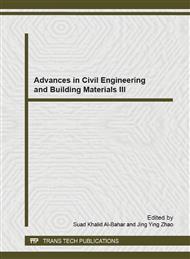p.3
p.9
p.14
p.18
p.23
p.27
p.32
p.36
Diffusivity Resistance of Concrete Systems in Chloride Rich Environment for Corrosion Protection of Embedded Steel Bars
Abstract:
Improving concrete performance and minimizing corrosion-induced deterioration of reinforced concrete structures are mandated Building Codes Practices and Specifications in arid regions such as the Arabian Gulf. Concrete structures resist corrosion due to the passivating properties of the hydrated cement around the steel reinforcement created by the high alkaline environment within the composite structure (pH > 12). However, the presence of chloride ions in the pore structure of the concrete destroys this passivating layer, which makes the steel reinforcement vulnerable to chloride-induced corrosion attack that accelerates degradation and deterioration of concrete structures. Corrosion activities-related tests such as Time-to-Corrosion Initiation (Modified ASTM G-109)6, and Corrosion Rate Test (Lollipop Test), can be effectively used to monitor the behavior of corrosion development, while chloride ingress characteristics tests such as Electrical Indication of Concretes Ability to Resist Chloride Ion Penetration ASTM C-1202-91)7, and the Resistance of Concrete to Chloride Ion Penetration (AASHTO T 259-80)8, are applied to evaluate the rate at which chloride ions can diffuse through concrete to onset the time-to-corrosion initiation, which will impact the structure service life and compromise its sustainability. Efforts have been made by scientists to develop mathematical simulation models that predict the service life of the structure based on Ficks Second Law for semi-finite diffusion of chloride ions, concentrated at different concrete depths. The study concluded that mineral admixtures have contributed to the enhancement of concrete performance and its resistance to chloride diffusivity, as well when in combination with corrosion-inhibiting admixture such as calcium nitrite.
Info:
Periodical:
Pages:
3-8
Citation:
Online since:
December 2013
Authors:
Price:
Сopyright:
© 2014 Trans Tech Publications Ltd. All Rights Reserved
Share:
Citation:


